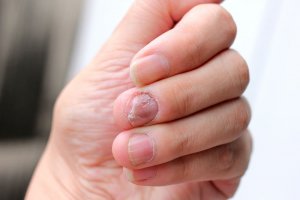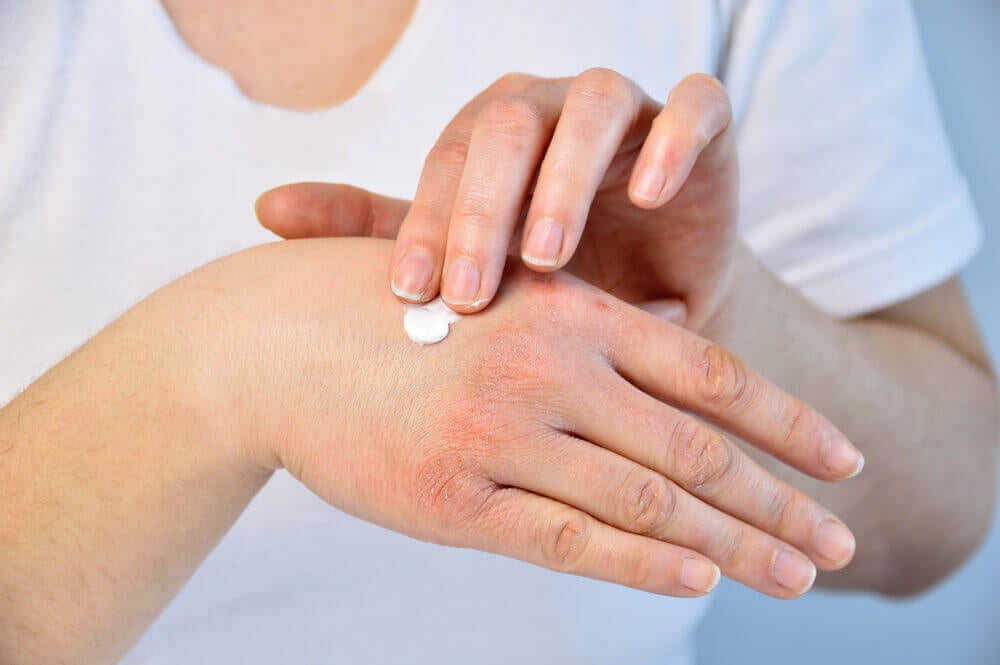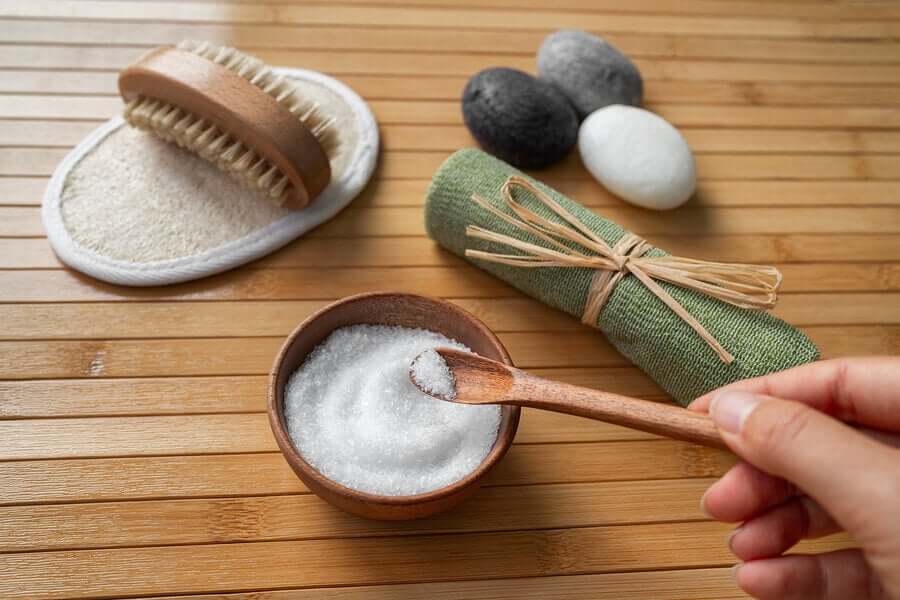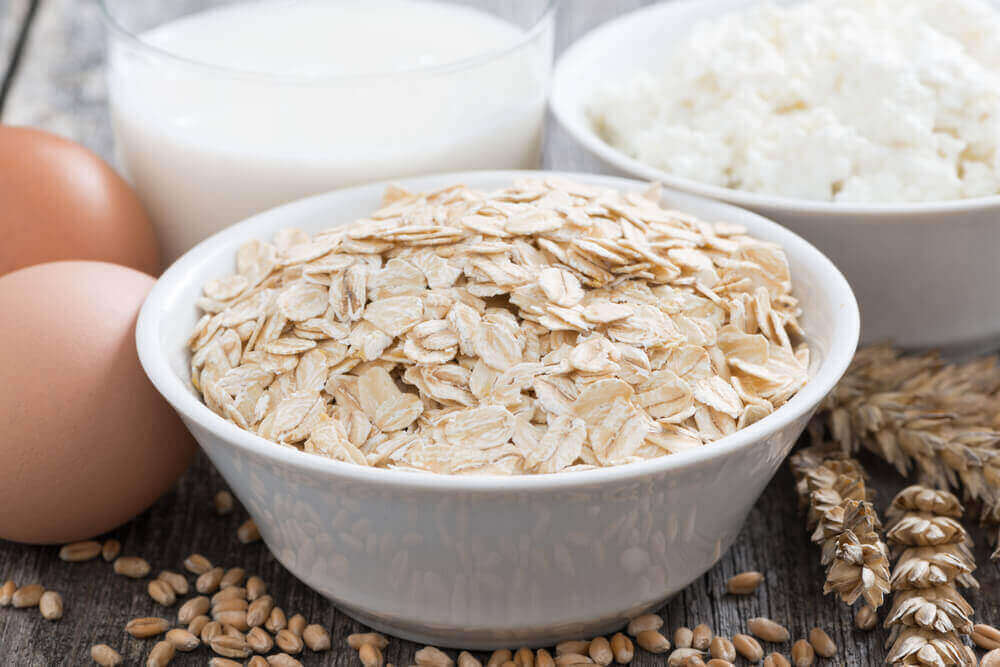5 Natural Remedies for Psoriatic Nails


Reviewed and approved by the doctor Karla Henríquez
Psoriasis can be uncomfortable and even painful. This disease affects any part of the skin and it’s common for it to start on the nails. In this article we will propose 5 natural remedies for psoriatic nails.
However, it’s important to clarify that these don’t represent a first-line treatment. And, moreover, evidence to prove their effectiveness is lacking. They should, therefore, be considered merely as a complement and not as a substitute for medical treatment.
What is Psoriasis?
Psoriasis is a chronic condition that manifests itself in the form of thickened and inflamed scaly lesions. It’s not a contagious disease but, due to the fact that the skin affectations can become severe, it usually affects the patient’s quality of life.
Among the causes of its appearance are trauma, respiratory tract infections, and endocrine factors during puberty, for example. Although there are many types, one of the most frequent is nail psoriasis.
Our dead skin cells in the epidermis, the top layer of the skin, are replaced with new cells. This process happens roughly every 30 days. However, as detailed in a publication in Drugs magazine, nail psoriasis causes an accelerated renewal of nail cells, altering the physical appearance of the nail.
Lesions are more common on the hands than on the feet and are often very painful. In addition, it’s estimated to affect 80-90% of patients with plaque psoriasis, and is even more common in patients with psoriatic arthritis.
It can manifest itself in various ways
- Dimples or dents on the nail, as if they’d been pricked with a needle.
- Thickening of some areas of the nail or the entire nail.
- Yellow or pinkish marks on the tips of the nails which can cause breakage on the sides.
- Loss of shine and a rough look to the nails.
- Breakdown of the nail which causes a sawdust-like powder under the nail.
- Affected nails can be very fragile.
Since nails grow very slowly, it’s quite common for people to become disheartened at how long it takes to see the results of treatment. Treatment for psoriatic nails needs to be continuous and supervised to stop people giving up too soon.
Read: Combat Psoriasis with These Natural Remedies
5 Natural Remedies for Psoriatic Nails
Treatments for psoriatic nails generally don’t leave people satisfied and tend to be focused mainly on cases where there’s a functional deterioration or where there’s considerable visible damage.
According to information published in the Brazilian Annals of Dermatology, it’s important to perform a thorough evaluation of the symptoms in order to determine the appropriate treatment.
Treatment may involve the use of topical or intralesional corticosteroids, clobetasol propionate 0.05% in the form of gel or cream, among other medications.
However, there are some natural alternatives that you can make at home to address the effects of psoriatic nails. We’ll tell you about them below.
1. Use Creams with Vitamin D

Vitamin D has anti-inflammatory properties and boosts the healing of the nails when they’re damaged.
Therefore, as a study published in the Journal of Dermatological Treatment concludes, creams or lotions containing this vitamin are useful for treating nails with psoriasis.
- Spread the cream or ointment over the nail for 5 minutes. Apply this treatment 2 to 3 times per day.
- It’s also a good idea to consume food that contains vitamin D to help the healing process internally as well as externally.
2. Aloe Vera
Aloe vera contains carricin, creatinine, emolin, phosphates, saponins, and phytosterols that confer analgesic, healing, anti-inflammatory, and antiseptic properties.
Therefore, its topical application is a good remedy to soothe the symptoms caused by nail psoriasis.
In fact, the latter is supported by research published in the Journal of the European Academy of Dermatology and Venereology, which highlights that aloe vera cream is more effective against psoriasis compared to 0.1% triamcinolone acetonide.
As a treatment, use the gel from the inside of an Aloe vera stalk to rub the affected nails. Leave it on for about 30 minutes and wash the area.
You can also extract the sap from the stem and apply it directly on the surface of the nails overnight. Remember to always clean the area in the morning with plenty of water.
You might like: 6 Ways to Use Aloe for Better Health
3. Epsom Salt Solution

As a way to complement some of the conventional treatments used by doctors, a warm water bath with Epsom salts is said to be a home remedy.
These salts are said to relieve itching and irritation caused by psoriasis. However, there’s a lack of scientific evidence to confirm this.
- Fill a bowl with warm water and add 2 tablespoons of Epsom salts.
- Submerge your nails in the bowl for 20 to 30 minutes.
- Dry with a clean cloth and moisturize with a cream containing vitamin D or a medicinal oil.
4. Arnica Oil
According to a publication of the medical journal Planta Medica, this oil has anti-inflammatory functions. Therefore, it could be useful to protect the affected nails and accelerate their recovery.
Instructions
- Mix 1 cup of olive oil and 2 cups of arnica flowers in a bowl.
- Leave in a dark place for 7 to 10 days. Then, strain the mixture and use it as it is by applying to your damaged nails.
5. Oats

Avena sativa, so useful in the cosmetic industry, provides many benefits in the treatment of skin lesions such as eczema, dermatitis, and pruritus, as noted in a review published in the Indian Journal of Dermatology, Venereology and Leprology.
In the case of nails, it is considered moisturizing and restorative. However, there is still no evidence to prove its efficacy against psoriasis. In any case, this treatment with oatmeal is safe and very simple:
- Add 2 tablespoons of oat flour and warm water in a bowl and mix well.
- Submerge your hands or feet in the mixture for 20 minutes.
- You can also increase the quantities and take a complete bath of the mixture to improve your skin’s appearance.
Want to know more about psoriatic nails? Consult your doctor
Although there’s still no definitive cure for psoriasis, there are many treatments available on the market, as well as different natural recommendations that can help treat this condition. The most important thing, however, is to consult a specialist when the first symptoms appear.
All cited sources were thoroughly reviewed by our team to ensure their quality, reliability, currency, and validity. The bibliography of this article was considered reliable and of academic or scientific accuracy.
- Rich, P., & Manhart, R. (2017). Nail psoriasis. In Psoriasis, Second Edition. https://doi.org/10.1201/9781315119298
- Pasch MC. Nail Psoriasis: A Review of Treatment Options. Drugs. 2016;76(6):675–705. doi:10.1007/s40265-016-0564-5
- Schons KR, Knob CF, Murussi N, Beber AA, Neumaier W, Monticielo OA. Nail psoriasis: a review of the literature. An Bras Dermatol. 2014;89(2):312–317. doi:10.1590/abd1806-4841.20142633
- Balbás, G. M., Regaña, M. S., & Millet, P. U. (2009). Tacalcitol ointment for the treatment of nail psoriasis. Journal of Dermatological Treatment. https://doi.org/10.1080/09546630902787585
- Chapman, A., & El Miedany, Y. (2017). Psoriasis. In Comorbidity in Rheumatic Diseases. https://doi.org/10.1007/978-3-319-59963-2_4
- Menter, A., & Griffiths, C. E. (2007). Current and future management of psoriasis. Lancet. https://doi.org/10.1016/S0140-6736(07)61129-5
- Rich, P., & Scher, R. K. (2003). Nail Psoriasis Severity Index: A useful tool for evaluation of nail psoriasis. Journal of the American Academy of Dermatology. https://doi.org/10.1067/S0190-9622(03)00910-1
- Pazyar, N., Yaghoobi, R., Kazerouni, A., & Feily, A. (2012). Oatmeal in dermatology: A brief review. Indian Journal of Dermatology, Venereology and Leprology. https://doi.org/10.4103/0378-6323.93629
This text is provided for informational purposes only and does not replace consultation with a professional. If in doubt, consult your specialist.








